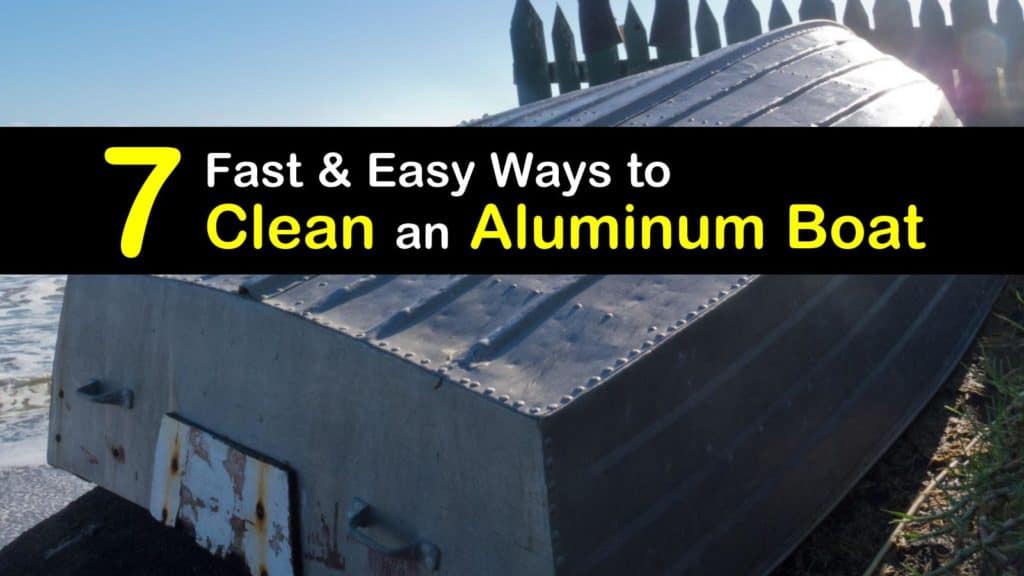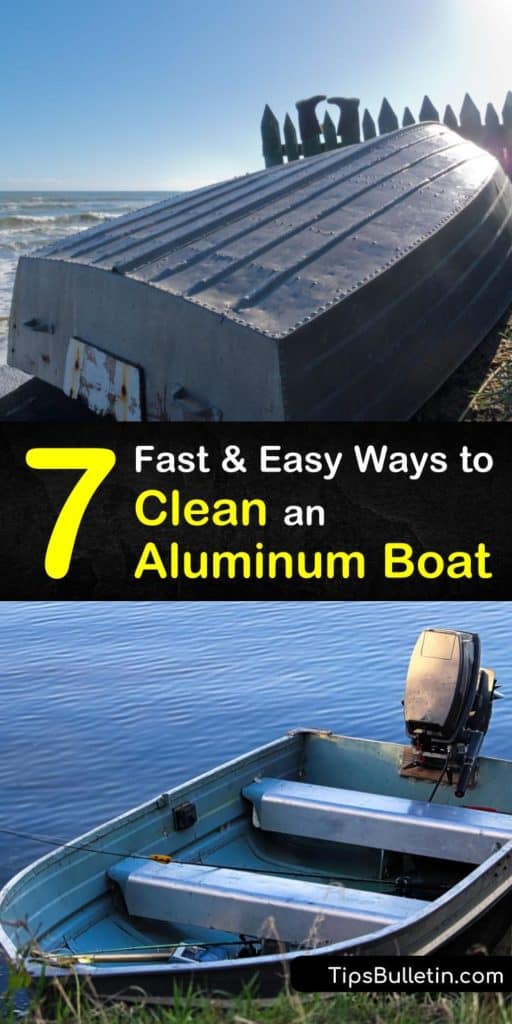A boat’s hull is commonly made from one of four materials: steel, fiber-reinforced plastic or FRP, polyethylene, or aluminum. Each of these has its pros and cons. However, they also have their own required maintenance routines to keep up the appearance and longevity. It is essential to know how to clean an aluminum boat if you have a boat made with an aluminum hull.
One of the main reasons that aluminum is a hull material in boats and the tubing on pontoons is because of the property that makes it impervious to most damaging rusts.
This defense doesn’t mean that it isn’t impacted by other corrosive elements, including the wear and tear of water, algae, harmful bacteria, or different marine life such as barnacles. These can cause discolorations and may even penetrate through the finish of the hull.

Ways to Clean Aluminum Boats
There are several effective ways to clean an aluminum boat, including options to make a homemade aluminum boat cleaner if you would rather not spend the money on a specific aluminum cleaner.
Cleaning aluminum boats that are commonly used in fresh water is also a bit different than when the boat owners take them out to sea.
Also, pay attention to the other materials your boat is made from. While jon boats may be constructed entirely from aluminum, a pontoon boat may only have parts that are aluminum. Using cleaning products specifically made for aluminum surfaces may stain them or may not be effective.
Before using any methods given below, be sure to remove any expensive electronics, like a tracker, from the inside.
For wooden parts of your boat, if applicable, use a natural teak cleaner for boat decks or another wood cleaner that will get rid of dirt and salt accumulation.
How to Clean an Aluminum Boat using Car Soap
The first alternative should always be the easiest and cheapest option. If your boat doesn’t require a deep clean, for instance, if you maintain it very well or only take it out infrequently, clean your boat as you would your car.
Even if you aren’t familiar with cleaning a boat, most people are reasonably accustomed to washing their cars. Cleaning an aluminum boat works the same as long as it doesn’t have too much buildup.

Similar to cleaning aluminum wheels on your car, fill a bucket with water and car soap and rinse the boat off with the garden hose. Then, dip the non-abrasive scrubber into the water and scrub it down thoroughly.
Rinse off the excess dirt and soap. If there are still dirty parts, do it again, or move on to one of our more aggressive cleaning techniques.
Power Washer
Using a pressure washer is an excellent step in the general maintenance of boat ownership. A boat doesn’t demand to be washed with an expensive cleaner every time you go out.
The best part about using this tool is that it serves as an ideal DIY boat cleaner for fiberglass boats as well as aluminum ones.
Once the fun and games are over on the water, attach a pressure washer soap nozzle to the end of a water hose. Start by using a biodegradable soap to keep it safe and protect the exterior of the boat.
Spray the boat with the power wash sprayer from the bottom to the top. Let the soap soak for five minutes, but be sure it doesn’t dry on the boat as this only adds another layer of grime.
Spray the boat down from top to bottom to wash off all of the detergent. Don’t miss any part of the boat, including an outboard on some smaller fishing boats. Flush the motor out to get rid of any trapped detergent.
Steel Wool and Elbow Grease
The next option for cleaning cast aluminum once the soap and water mixture has cleaned off most of the scum on the boat is good old elbow grease. All this process takes is some time and a scrubber with enough abrasion to get off the particularly stuck-on material from the water.
Soak these with water from a standard hose and then get after it with a scrub brush. Only use steel wool if it is going to take extra work to get through the grime as it can etch the surface of the boat.
If you notice a rusty spot, take care of it immediately so it doesn’t spread. Get rust off aluminum with the steel wool but don’t scrub too hard.
After you finish scrubbing, use an aluminum polish to protect the outside of the boat. A metal polish also keeps up appearances, keeping the boat looking as good as new.
Vinegar as a Homemade Aluminum Boat Cleaner
Vinegar as a cleaning solution works effectively on just about anything. It also happens to make a great homemade aluminum boat cleaner. It’s great to restore anodized aluminum, too. Vinegar is acidic, and aluminum is a base metal.
Spraying vinegar on aluminum pontoons or as a hull cleaner for aluminum boats generates a reaction where the metal neutralizes the solution. This effect works through much of the grime that collects on a boat.
This solution is not typically enough to wash an entire boat down, but it helps to eliminate discolorations and water spots. You can also use baking soda to clean aluminum if you don’t have white vinegar on hand.
To deep clean aluminum, start by cleaning the outside of the boat with soapy water to locate the spots to wash with vinegar. Fill the spray bottle with a 50/50 mixture of vinegar and water.
Spray it on the water spots, along the waterline or other appropriate areas on the boat hull, and leave it there for 60 seconds, as long as it isn’t running down the side of the boat.
For getting rid of corrosive algae, use a non-abrasive scrubber to wipe away the mixture and dirt, rinsing the vinegar away thoroughly to remove stains and stop the acidic reaction that can damage a boat if left for too long.
Polishing anodized aluminum surfaces has never been easier – and cheaper.
Bleach Solution
Boat cleaning with an ammonia solution isn’t usually one of the first ways to clean aluminum boats. However, it is an effective restorer to kill algal growths or bacteria that haven’t come off through the first rinses with soap and water.
In this case, protecting yourself from getting bleach in your eyes or on your skin is even more important than cleaning the boat, so be sure to use protective gear.
Begin the process by protecting yourself, putting on old clothes that cover your skin, safety goggles, and latex gloves. Mix up the water and bleach solution in the bucket.
Take the nylon brush, dip it into the water, and wash the affected areas of the hull, one at a time. With circular motions, remove all the algae buildup. Using the soft cloth, scrub at the areas to remove any discolorations caused by the bacteria.
Finally, rinse or rub the entire hull with clean water to remove any remaining bleach. Bleach that is left can cause tinting or crust to form on the surface.
How to Clean an Aluminum Pontoon Boat
When cleaning a large aluminum surface like a pontoon boat, you may have to employ several cleaners, depending on the amount of discoloration and grime. Make a aluminum pontoon cleaner and wipe down the pontoons or, for easier application, add it to a power washer. Be sure to rinse well.
Cleaning an aluminum pontoon boat is really not much different than washing any other type of boat. Bare aluminum responds to a variety of cleaners and most offer a brilliant shine when you are finished. There may be times, though, when you don’t have the time to mix up a natural cleaner when you clean an aluminum pontoon. That’s when you can turn to a product from the store.
Commercial Products
Many boat owners recommend using products specifically meant for cleaning aluminum. These don’t need to be used every single time you clean your boat, perhaps only once or twice a year. There are many options out there, but some are more loved than others.
These three are some of the more common options, with Toon-Brite often receiving the label of the best cleaner for fiberglass boats or the ultimate aluminum cleaner. Whatever cleaning product you decide to use has instructions listed on the side.
Typically, when using a boat cleaner, you start by spreading it across the boat, using a brush to ensure even coverage over the whole surface. Allow it to soak into the grime for 5-10 minutes.
Re-apply on any especially dirty areas. Once you finish, rinse the boat off thoroughly to keep from adding more corrosive elements to the exterior.
Boat Wax
Maintaining the cleanliness of your boat is just as important as doing the general washes each time you clean it. The overall maintenance also helps to streamline the shorter cleans.
To maintain it, use a boat wax once a year. Apply the boat wax one or two days after doing a thorough wash, making sure it is sparkling clean.
Wax the whole boat with boat wax, following the instructions that come with the wax you choose. Carefully avoid waxing the non-skid surfaces, if there are any.
Maintaining a clean boat not only increases the longevity of the boat hull or a pontoon’s tubing, but it also makes you the envy of other boaters.
It keeps the boat looking fresh and new, ready to take on any new water adventure you have in store. All of this is why it is useful to know how to clean an aluminum boat.

We hope that you learned some useful tips and tricks when it comes to removing any algae, discoloration, or grime from your boat. If you liked our post about cleaning an aluminum boat, please share our aluminum cleaning tips on Facebook or Pinterest.